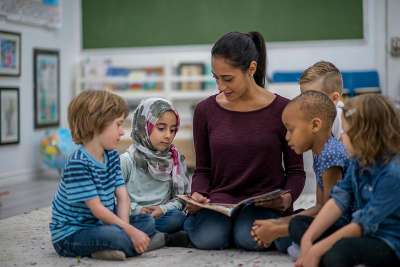Performance
Having a lot of knowledge is one thing. Being able to pull together bits and pieces of knowledge is another thing. But the crux of a good lesson is the opportunities for students to use their knowledge in productive, hands-on learning tasks.
Independent Practice
This method is one in which each student has an opportunity to use previously learned material on a specific academic task. For example, after learning about the short a sound, first-grade students might each locate short a words in a book they can read on their own. Or after learning about how to determine the square root of a number, students might figure out the square roots of a column of numbers from their math textbook.
Debriefing
Usually conducted at the conclusion of a lesson, debriefing allows students to condense and coalesce their knowledge and information as a group or whole class. It is an active thinking process.
It's Elementary
Role-plays are typically short, lasting for a maximum of 15 minutes. The best ones are those in which two or more students engage in a dialogue about a specific event or circumstance. Keep the directions you provide to a minimum; this is a wonderful opportunity for students to capitalize on their creativity.
Role-Playing
In this event, a student (or students) takes on the role of a specific individual (a historical person, for example) and acts out the actions of that person as though he were actually that person. The intent is to develop a feeling for and an appreciation of the thoughts and actions of an individual.
Modeling
In this method, you model the behavior students are to duplicate within an activity and encourage students to parallel your behavior in their own activity. Students may model appropriate behavior for each other, too.
Simulations
Simulations are activities in which students are given real-life problem situations and asked to work through those situations as though they were actually a part of them.
Every simulation has five basic characteristics:
They are abstractions of real-life situations. They provide opportunities for you to bring the outside world into the classroom.
The emphasis is on decision-making. Students have opportunities to make decisions and follow through on those decisions.
Students have roles that parallel those in real life (mother, father, child).
The rules are simple, uncomplicated, and few in number.
A simulation has two or more rounds—opportunities to make decisions more than once.
If you've ever played the games Monopoly, Clue, or Life, you have been part of a simulation. Potential classroom simulations may include some of the following:
A sixth-grade “family” is sitting around a table deciding how they'll spend their monthly income. How much will be spent on food, the mortgage, medical bills, transportation, etc.? Unexpectedly, the car needs a new transmission. Will the family be able to go to a movie this weekend?
A third-grade class has been divided into various “neighborhoods.” What factors will ensure that everyone's needs are satisfied? What kinds of stores or markets do they need? Where will the schools be located? What are some of the essential services? What are some of the critical transportation issues?
Projects
Students are allowed to create their own original designs, models, or structures to illustrate an important point or content fact. These can take many forms and formats:
mobiles
dioramas
shadow boxes
posters
newspapers
brochures
flyers
letters to the editor
collages
three-dimensional models
Skill Practice
Here, you provide students with an opportunity to apply their newly learned skills in a true-to-life experience. The emphasis is on the use of those skills.
Guided Practice
In this event, students are allowed to experience all the events of a learning situation. Usually the work is done individually, although it can be done collectively, too. The teacher is a facilitator and a cheerleader.
Reflective Inquiry
This method is student-initiated and student-controlled. Individual students are encouraged to select a topic they want to investigate further. In so doing, they pose a series of questions that they want to answer on their own. The questions are typically higher-order questions (see Levels of Questions)and emphasize a variety of divergent thinking skills.
Vary Your Lessons
If you'd like to make every lesson successful, you must do one thing: include a variety of teaching and learning methodologies in every lesson. If variety is the spice of life, then fill your lessons with lots of spice as you incorporate multiple teaching strategies.
Here's a good rule of thumb: For every lesson, try to include at least one knowledge method, one synthesis method, and one performance method. That way, your students are getting the necessary information; they're pulling together that information into a comprehensible whole; and they're afforded opportunities to use that information in a creative and engaging way.















